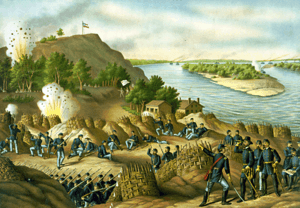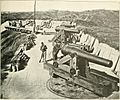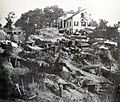Siege of Vicksburg facts for kids
Quick facts for kids Siege of Vicksburg |
|||||||
|---|---|---|---|---|---|---|---|
| Part of the Vicksburg campaign of the Western Theater of the American Civil War | |||||||
 The Siege of Vicksburg by Kurz and Allison |
|||||||
|
|||||||
| Belligerents | |||||||
| Commanders and leaders | |||||||
| Ulysses S. Grant | John C. Pemberton |
||||||
| Units involved | |||||||
| Army of the Tennessee | Army of Mississippi | ||||||
| Strength | |||||||
| ∼ 77,000 | ∼ 33,000 | ||||||
| Casualties and losses | |||||||
| 4,835 total
(766 killed
3,793 wounded 276 captured/missing) |
32,697 total
(3,202 killed/wounded/missing
29,495 surrendered) 172 cannons captured by United States 1 camel killed |
||||||

The Siege of Vicksburg was a very important event in the American Civil War. It happened from May 18 to July 4, 1863. During this time, the Union Army, led by Major General Ulysses S. Grant, surrounded the city of Vicksburg, Mississippi. Vicksburg was a strong fortress city held by the Confederate Army, led by Lieutenant General John C. Pemberton.
Capturing Vicksburg was a big goal for the Union. It was the last major Confederate stronghold on the important Mississippi River. Taking control of the river would help the Union split the Confederacy in two. This was a key part of the Union's war plan, sometimes called the "Anaconda Plan."
Grant's army tried to attack Vicksburg twice, on May 19 and May 22. Both attacks failed, and the Union soldiers suffered many losses. Because direct attacks didn't work, Grant decided to start a "siege" on May 25. This meant his army would surround the city and cut off all supplies.
Contents
What Was the Siege of Vicksburg?
Vicksburg was a very important city for the Confederacy. It sat on high cliffs overlooking the Mississippi River. This made it a perfect place to control river traffic. If the Union could take Vicksburg, they would control the entire Mississippi River. This would stop the Confederacy from moving supplies and troops easily. It would also cut off the western Confederate states like Arkansas and Texas from the rest of the Confederacy.
The Union's plan was to "squeeze" the Confederacy. They wanted to block their ports and control their rivers. Taking Vicksburg was a huge step in this plan. It would be like cutting the Confederacy in half.
Why a Siege?
After two failed attacks, General Grant realized that attacking Vicksburg directly would cost too many lives. The Confederate defenses were too strong. So, he decided to try a different approach: a siege.
A siege is when an army surrounds a city or fortress. They cut off all food, water, and supplies. They also constantly attack with cannons and try to dig tunnels under the defenses. The goal is to force the people inside to surrender because they run out of resources.
For over 40 days, the Union army kept Vicksburg surrounded. The soldiers and people inside the city faced very tough conditions. Food became scarce, and they had to live in caves dug into the hillsides to protect themselves from cannon fire.
The End of the Siege
The Confederate soldiers and the people of Vicksburg held out for a long time. But by early July, they were running out of everything. Their supplies were almost gone, and they were exhausted.
On July 4, 1863, General Pemberton and his Confederate army surrendered to General Grant. This was a huge victory for the Union. It meant they now controlled the entire Mississippi River. Just a few days later, another Confederate stronghold downriver, Port Hudson, also surrendered.
A Turning Point in the War
The surrender of Vicksburg on July 4, 1863, was a major turning point in the American Civil War. It happened just one day after another huge Union victory at the Battle of Gettysburg in Pennsylvania.
With Vicksburg captured, the Confederacy was truly split in two. It became much harder for them to move troops and supplies between their eastern and western states. President Abraham Lincoln called Vicksburg "The key to the war." This victory significantly weakened the Confederacy and helped the Union move closer to winning the war.
Images for kids
-
Shirley's House, also known as the White House, during the siege of Vicksburg, 1863. Union troops of Logan's division set about as engineers and sappers to undermine Confederate fortifications but they had to stay under cover for fear of Confederate sharpshooters.
See also
 In Spanish: Sitio de Vicksburg para niños
In Spanish: Sitio de Vicksburg para niños









